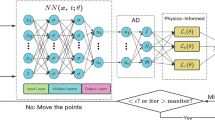Abstract
Different data assimilation methods such as an extended Kalman filter, the optimal interpolation method, and a method based on the Fokker-Planck equation applications are considered. Data from the ARGO drifters are assimilated into the HYCOM shallow water model (University of Miami, USA). Throughout the study, the schemes and methods of parallel computations with an MPI library are used. The results of the computations with assimilations are compared between themselves and with independent observations. The method based on the Fokker-Planck equation and the extended Kalman filter are preferable because they give better results than the optimal interpolation scheme. The various model characteristics of the ocean, such as the heat content fields and others, are analyzed after the data assimilation.
Similar content being viewed by others

References
V. P. Agoshkov, The Methods of Optimal Control and Adjoin Equation in the Mathematical Physics (Inst. Computat. Modeling, Moscow, 2003) [in Russian].
K. P. Belyaev, V. N. Solov’ev, and C. A. Tanajura, “The Method of Oceanographic Data Assimilation in a Joined “Ocean-Atmosphere” Model System and Its Application to the Analysis of Ocean in the Tropical Atlantic,” Okeanologiya 44, No. 1, 71–81 (2004).
K. P. Belyaev, N. P. Tuchkova, and I. Kirkhner, “The Method of Model Output Correction by Measurements of Diffusion Approximation and Its Application to the Analysis of Hydrophysical Parameters,” Mat. Model. 21, No. 3, 53–68 (2009).
K. P. Belyaev, N. P. Tuchkova, and U. Kubash, “Reaction of Joint “Ocean-Atmosphere” Model on the Data Assimilation in the Tropical Pacific,” Okeanologiya 50, No. 3, 306–316 (2010).
L. S. Gandin, Objective Analysis of Hydrometeorological Fields (Gidrometizdat, Leningrad, 1963) [in Russian].
G. I. Marchuk, Numerical Task Solution of the Dynamics of Atmosphere and the Ocean (Gidrometizdat, Leningrad, 1974) [in Russian].
E. Andersson, J. Haseler, and P. Undén, “The ECMWF Implementation of Three Dimensional Variational Assimilation (3D-Var),” Q. J. R. Meteorol. Soc. 98, 1100–1123 (1998).
K. Belyaev, C. A. S. Tanajura, and J. J. O’Brien, “A Data Assimilation Method Used with an Ocean Circulation Model and Its application to the Tropical Atlantic,” Applied Math. Modeling 25, No. 8, 655–670 (2001).
R. Bleck and D. B. Boudra, “Initial Testing of a Numerical Ocean Circulation Model Using a Hybrid Quasi Isopycnal Vertical Coordinate,” J. Phys. Oceanogr. 11, 755–770 (1981).
F. Counillon and L. Bertino, “High-Resolution Ensemble Forecasting for the Gulf of Mexico Eddies and Fronts,” Ocean Dyn. 59, 83–95 (2009).
J. A. Cummings, “Operational Multivariate Ocean Data Assimilation,” Quart. J. Roy. Meteor. Soc. 131C, 3583–3604 (2005).
G. Evensen, “Using the Extended Kalman-Filter with a Multilayer Quasi-Geostrophic Ocean Model,” J. Geophys. Res. 97, No. C11, 17905–17924 (1991).
R. Kalman, “A New Approach to Linear Filtering and Prediction Problems,” J. Basic Engineering 82, 35–45 (1960).
G. Evensen, “Using the Extended Kalman-Filter with a Multilayer Quasi-Geostrophic Ocean Model,” J. Geophys. Res. 97, 17905–17924 (1991).
W. C. Thacker and O. E. Esenkov, “Assimilating XBT Data into HYCOM,” J. Atmos. Ocean. Tech. 19, 709–724 (2002).
Author information
Authors and Affiliations
Corresponding author
Additional information
Original Russian Text © K.P. Belyaev, C.A.S. Tanajura, N.P. Tuchkova, 2012, published in Okeanologiya, 2012, Vol. 52, No. 5, pp. 643–653.
Rights and permissions
About this article
Cite this article
Belyaev, K.P., Tanajura, C.A.S. & Tuchkova, N.P. Comparison of methods for argo drifters data assimilation into a hydrodynamical model of the ocean. Oceanology 52, 593–603 (2012). https://doi.org/10.1134/S0001437012050025
Received:
Accepted:
Published:
Issue Date:
DOI: https://doi.org/10.1134/S0001437012050025



